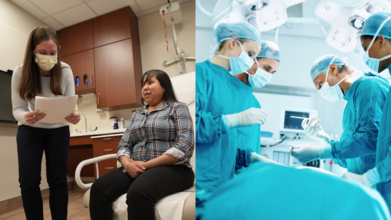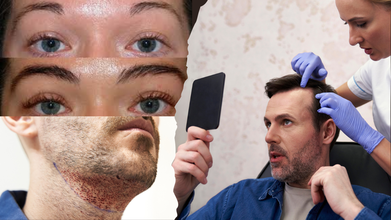- Health Conditions A-Z
- Health & Wellness
- Nutrition
- Fitness
- Health News
- Ayurveda
- Videos
- Medicine A-Z
- Parenting
- Web Stories
Forget The Hard-to-Pronounce Acids: Magnesium and Zinc Are Real Skin Heroes

Skin Care (Credit: Canva)
If you cannot pronounce it, then it is probably not good for you. But does this advice work when it comes to skincare? Perhaps not. With facial acids like hyaluronic, salicylic and niacinamide filling the market up to the brim, skincare has become a tenacious process. However, what if I told you that two simple, easily available nutrients are enough to give you purple and wrinkle-free skin?
Zinc
Zinc is an essential nutrient found in a variety of plant and animal foods. It is crucial for immune function as well as cell growth. The importance of this mineral in skin health comes from its power to reduce sebum, which is the oily substance that clogs pores. Therefore, if you are someone dealing with pimples or acne, then increasing Zinc in your diet is the solution. It also helps you fight oily skin and chronic eczema as it promotes skin repair.
Zinc is available in various dietary supplements, including multivitamins and single-ingredient formulations. Common forms include zinc sulfate, zinc acetate, and zinc gluconate. While these forms are often used interchangeably, research has yet to determine if one is significantly better than the others.
Magnesium
Magnesium, on the other hand, works behind the scenes to keep your skin healthy and glowing. This essential nutrient is responsible for making you fall asleep and maintaining a healthy sleep cycle. Magnesium deficiency in people leaves them struggling with dark circles.
To ensure adequate magnesium intake, individuals can primarily rely on their diets. Foods rich in magnesium include pumpkin and chia seeds, green leafy vegetables like spinach, legumes, nuts, and whole grains. A good rule of thumb is that foods high in fiber typically contain magnesium. Additionally, fish such as salmon and mackerel, along with fruits like bananas, are excellent sources of this essential mineral.
Meet This 32-Year-Old Woman, Who Survived Triple Organ Transplant And Cancer That Left Her Blind

(Credit-Northwestern Memorial Hospital/Canva)
It is not always that people get a second chance to change their lives. Terrible tragedies that can leave people struggling with illnesses and life-long disabilities, due to no fault of their own, can happen to anyone. However, this was not a story for her, it was her reality.
Jessica Lopez was diagnosed with cancer as an infant. The treatments saved her life, but they also caused long-term damage to her heart. By the time she was in her early 30s, she was facing a dire situation: her heart, liver, and kidneys were all failing. Her only hope was a rare and risky triple-organ transplant.
In a news release, her doctors at Northwestern Memorial Hospital explained how they were determined to help her. Despite the slim odds—this type of transplant had only been performed 59 times in the U.S. before—her positive attitude inspired them to take on the challenge.
Can Childhood Cancer Lead To Organ Failure?
As a child, Jessica battled leukemia and an eye cancer that left her blind. Although she beat the cancer, the aggressive treatments had a lasting effect. Unfortunately, it's not uncommon for childhood cancer survivors to have a much higher risk of heart problems later in life due to the harsh impact of treatments. In Jessica's case, her doctors believe this is what led to her heart failure, which then caused her liver and kidneys to fail.
After being placed on the transplant list, Jessica waited for a matching donor. The wait for three organs is especially long because they all must come from a single person. However, on February 24, a match was found.
The surgery was incredibly complicated. A team of surgeons worked together to transplant the heart and liver at the same time, followed by a separate procedure for the kidney. This allowed them to complete the surgery as quickly as possible.
Who Needs a Triple-Organ Transplant?
According to Mayo Clinic, triple-organ transplants are considered for people whose disease has damaged three of their major organs. For example, a person with severe heart failure might have a damaged heart that then causes their liver and kidneys to fail. In other cases, a problem with the liver or kidneys can lead to heart failure.
Because this surgery is so demanding on the body, doctors look for patients who are otherwise in good health. The patients who receive these transplants are often children or young adults, but older patients have received them as well.
What Are The Risks of Triple-Organ Transplant?
Getting a triple-organ transplant is a long and difficult process. First, the patient is put on a special transplant list, waiting for a single donor who can provide all three organs.
The surgery itself is extremely complex and can last for many hours. The heart is transplanted first, since it is the most fragile organ. The surgical team works with a detailed plan, like a "playbook," to make sure everything goes smoothly.
While a triple-organ transplant offers a chance at life for patients who have no other options, it also comes with higher risks than a single-organ transplant. The patient is at risk for serious complications like bleeding and infection. However, a highly skilled medical team can catch and treat these problems early, which is key to success.
A New Chance At Life
Jessica's journey back to health has been long, but she is now thriving with her new organs. She says she feels "reborn" and has more energy than ever. She has a stronger heartbeat and is filled with gratitude for her organ donor's selfless choice, which gave her a second chance at life.
Jessica, who has been cancer-free for 20 years, has never let being blind stop her from living a full life. She navigates her world with ease and is even planning a new career in forensics. She is also happily planning her wedding for 2026, looking forward to a bright future with her fiancé.
COVID-19 Vaccine Update: You Are Eligible For The Vaccine If You Have These Conditions

(Credit-Canva)
Currently US is experiencing changes in their COVID vaccine guidelines. In the past few weeks, the Center of Disease Control and Prevention changed their vaccine eligibility guidelines for children, giving parents and their healthcare professionals the autonomy to choose whether they want to get their children vaccinated. This was a highly contested decision, so much so that the American Association of Pediatrics released their own guidelines stating that all children ages 6 to 23 months should get the vaccine.
This year's updated COVID-19 vaccines have been approved by the U.S. Food and Drug Administration (FDA) with a more specific focus. The approval is for adults aged 65 and older and for younger people who have certain medical conditions that put them at a higher risk for severe COVID-19.
Federal health officials say that anyone who wants a vaccine can still get one after talking with their doctor. However, this narrower approval might make it harder for some people to get a shot if they don't meet these specific criteria.
Who Is Eligible For The COVID-19 Vaccine?
According to the U.S. Department of Health and Human Services, the new vaccines from Moderna, Pfizer, and Novavax are available for people at higher risk. The Centers for Disease Control and Prevention (CDC) has a long list of conditions that can put someone at higher risk for a severe COVID-19 infection. These include common issues like
- Asthma
- Blood cancers
- Cerebrovascular diseases
- Chronic kidney disease
- Some chronic lung diseases
- Some chronic liver diseases
- Cystic fibrosis
- Type 1 and 2 diabetes
- Gestational diabetes
- Disabilities, including Down syndrome
- Heart conditions
- HIV
- Mood disorders, including depression and schizophrenia
- Dementia
- Parkinson’s disease
- Obesity
- Physical inactivity
- Current or recent pregnancy
- Primary immunodeficiencies
- Current or former smoking
- Solid organ or blood stem cell transplant recipients
- Tuberculosis
- Use of immunosuppressive drugs
What Are The Major Risk Factors For COVID-19?
According to the CDC COVID-19 while having an underlying health condition is a big risk factor for severe COVID-19, other things can also increase a person's risk. Age is the biggest risk factor. For example, people ages 50 to 64 have a risk of death that is 25 times higher than people ages 18 to 29. The risk keeps going up with age:
Ages 65-74: 60 times higher risk of death
Ages 75-84: 140 times higher risk of death
Ages 85+: 340 times higher risk of death
Race and Ethnicity also play a role. The pandemic has had a more severe impact on racial and ethnic minority groups. These groups are more likely to get COVID-19, be hospitalized, end up in the ICU, or die from the disease—often at a younger age. This is often due to problems with healthcare access, like not having health insurance or reliable transportation.
What Are Some Other Condition That Are At Risk of COVID?
For some health issues, the link to severe COVID-19 isn't as clear and needs more research. These include epilepsy, hemophilia, sickle cell disease, and substance use disorders. Other conditions, like high blood pressure and Hepatitis B or C, have shown mixed results in studies, so it's not yet certain if they increase a person's risk of severe illness.
The CDC also mentions that doctors should look at a patient's age, health problems, and vaccination status to determine their risk. Here's what they should do:
Suggest Vaccination
Encourage patients to get the updated COVID-19 vaccine, as it's safe and effective.
Prescribe Treatment
Give antiviral medicines early to eligible patients to significantly lower their risk of hospitalization and death.
Encourage Prevention
Advise high-risk patients to continue wearing masks and to keep up with their regular medical appointments to manage their health conditions.
Help Everyone
Be sensitive to the needs of different groups, including racial and ethnic minorities. Doctors should offer resources and support to help all patients get the care they need.
Not Just Bald Spots, Are Beard And Eyebrow Transplants The Next Millennial Beauty Obsession

Credits: Pinterest/iStock
Beards that look sharp on Instagram, eyebrows that frame the face just right, even fuller lashes, hair is no longer about the scalp anymore. Millennials are becoming more and more interested in beard and eyebrow transplants in order to achieve their desired look. The demand is no longer niche, say surgeons, thanks to grooming culture, social media, and new technology making these once-rare procedures mainstream. What this actually means is that hair transplants are moving away from being corrective bald spot fixings to being a cosmetic option, nearly like fillers or Botox.
For decades, hair transplants were linked almost solely to scalp baldness, furtively discussed and reserved for men fighting male pattern hair loss. Skip forward to 2025, and the discussion has widened exponentially. Now, beard, eyebrow, and even body hair transplants are not merely available but increasingly popular across gender and age boundaries. What was once a niche or even an extreme surgery has entered mainstream cosmetic and reconstructive medicine.
Cultural grooming and identity trends have redefined hair restoration demand. Thick eyebrows, which were plucked thin back in the 1990s and early 2000s, are now the standard of beauty. Social media and celebrity culture have further fueled the popularity of full brows, encouraging both men and women to undergo eyebrow transplants to obtain definition and fullness.
Beards also went from being an afterthought to a strategic style choice. A thick, even beard has long been considered a sign of masculinity and confidence, and frustrated men are increasingly seeking out surgical solutions. According to board-certified plastic surgeon Dr. Mayank Singh, "Hair restoration is no longer just restricted to the scalp these days. There has been a significant increase in demand for beard, eyebrow, and body hair transplants in recent years." Though most still equate transplants with hair loss, the surgery has developed into one of the most rapidly expanding trends in cosmetic medicine.
Who Is Selecting Beard And Eyebrow Transplant Procedures?
The demographic spread is wider than one might expect. Women with naturally thin brows, those who lost eyebrow hair due to alopecia, thyroid disorders, or chemotherapy, and even individuals with facial scars are seeking eyebrow restoration not just for beauty but for function—eyebrows help protect the eyes from sweat and debris.
Beard transplants, on the other hand, are most prevalent among males between their 20s and 40s. Some simply desire a fuller beard for looks, others are covering areas of thinning, and for many transmen, beard transplantation is a key aspect of gender identity confirmation. Such reasons are more than fashion, bordering on self-concept, confidence, and cultural significance.
What Is The Artistry Behind Transplants?
Unlike hair transplants on the scalp, face hair transplants require an added degree of accuracy. Transplanted hair angle, direction, and density need to be in sync with natural growth direction and the person's facial structure. Eyebrows are especially fussy. One millimeter of error can make all the difference in expression and balance.
That's the reason why decent clinics place equal stress on surgery and art. Since Dr. Singh explains, not all demands are possible, "Dramatic demands—such as for unnaturally thick body hair or transplants to unusual places—call for serious thought. Ethical professionals always consider safety, long-term results, and if the look will be natural."
More Than Vanity What Is The Medical and Practical Motivation For These Procedures?
Although most of these procedures are done for aesthetics, the medical indications are equally significant. Loss of eyebrow hair through burns, trauma, or autoimmune disorders can impact function as well as appearance. Beard transplants, likewise, can replace hair destroyed by scarring or trauma. Here, the procedure is more about making a person look and act normal again and gaining confidence rather than sheer fashion.
Are Body Hair Transplants The Outer Edge of the Trend?
One of the more unexpected trends is the request for body hair transplants. Chest, arm, and even lower body hair restoration have been requested. Although not common, they highlight how grooming standards differ across cultures and individuals. For surgeons, though, these types of unusual cases raise ethical concerns. Priority must be placed on ensuring procedures are safe, medically warranted, and provide realistic results.
Permanency and Aftercare
One of the most important questions patients have is if hair that is transplanted is permanent. The answer is yes—since donor hair comes from the scalp, a region that is genetically thinning-resistant, so no thinning will occur. The hair will grow normally once it is transplanted in its new position.
That being the case, aftercare is a little different. Eyebrow transplants, as an example, employ scalp hairs that grow longer and faster, needing to be trimmed regularly. Beard transplants require strict short-term aftercare to avoid infection and graft survival but, once healed, become a routine part of grooming. Body hair transplants vary depending on location but in most cases work by the same principle of permanence.
Role of Social Media and Pop Culture
The boom in such procedures cannot be divorced from the role of pop culture. Trends in grooming, especially those amplified on TikTok and Instagram, have made cosmetic treatments the new norm. Celebrities with thick brows or highly groomed beards provide aspirational benchmarks which filter into day-to-day style.
But it's not simply about keeping up appearances. For many patients, the choice is more about identity, self-expression, and confidence issues. Facial and body hair transplants occupy a different position than scalp hair transplants on the continuum between aesthetic enhancement and empowerment.
Balancing Demand With Responsibility
The rapid growth of these operations has positioned it as one of the most rapidly expanding segments of cosmetic medicine. Nonetheless, surgeons caution. Unrealistic expectations or requests that are based only on fleeting trends may result in disappointment. Ethical practitioners, as Dr. Singh insists, know when to turn down a case, "The goal is always to balance patient expectations with long-term safety and natural-looking results."
With advancing technology, facial and body hair transplants should become even more advanced, with reduced recovery periods and more natural results. Gone are the days when this was whispered about; now it's widely talked about, with clinics claiming record levels of patients consulting for beard, eyebrow, and off-the-scalp procedures.
Hair transplantation's evolution captures a larger trend in the way we think about cosmetic medicine. It's no longer merely a matter of curing baldness but achieving a style that matches one's personality, self-image, and confidence. From facial-framing eyebrows to beards representing virility and maturity, hair restoration is redefining what it means to assume command of one's appearance.
The emergence of beard, eyebrow, and body hair transplants is a reflection of how far hair restoration has advanced. Historically confined to baldness on the scalp, today it extends to aesthetics, identity, and function in equivalent proportion. Whether motivated by medical necessity, cultural factor, or simply personal fashion, these surgeries are yielding results that are permanent, natural, and frequently transformative.
Dr Mayank Singh is a board certified plastic surgeon , also a Fellow of ISHRS , exclusively into hair restoration for over 15 years and the Founder of CROWN, New Delhi.
© 2024 Bennett, Coleman & Company Limited

